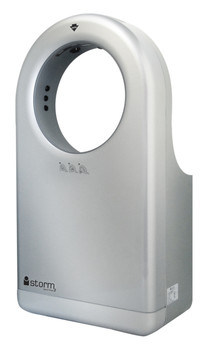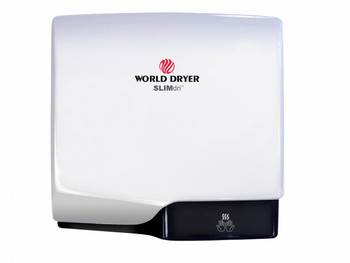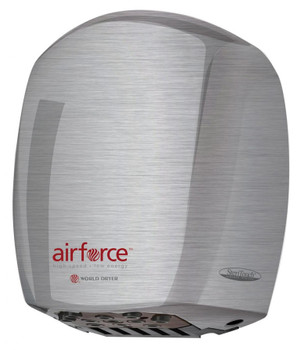ADA Compliant Hand Dryers
ADA-Compliant Hand Dryers are often a requirement with public facility requirements. ADA compliance means that the requirements of the Americans with Disabilities Act (ADA) have been met regarding handicap accessibility. The ADA defines the requirements for accessibility in the design and construction of public restroom spaces in the United States. Concerning hand dryers this generally means with the compact hand dryer installed it will protrude no more than 4” from the wall. An example of ADA hand dryers would be designed recess mounted hand dryers, surface mounted modular and compact hand dryers specifically designed for ADA compliance, or surface mounted hand dryers that are installed with their optional manufacturer recess kit that has specifically been designed to make the surface mounted hand dryer ADA compliant. Please note, with the last option, the optional recess kit must be used for the surface mounted hand dryer to be considered ADA compliant. If a hand dryer protrudes more than 4 inches from the wall, it can still be considered ADA compliant, but it must be mounted so that part of the hand dryer is below 27” from the floor to allow for cane detection for the visually impaired. When installed, ADA-compliant hand dryers protrude more than 4”, and part of it is at least 27” from the floor, the maximum high forward reach also needs to be 48” with the minimum low forward reach at 15”. * An example of these would be the Vertical Style Hand Dryers on HandDryerSupply.com. More and current handicap hand dryer height requirement information can be found on the US Access Board website.
Always consult with the architect or design engineer with questions regarding your project specific ADA hand dryer installation regulations. The ADA compliant hand dryers and compact hand dryers on HandDryerSupply.com have been noted by their manufacturer.
(*Source: ADA Accessibility Guidelines for Buildings and Facilities (ADAAG), Section 4. Accessible Elements and Spaces: Scope and Technical Requirements.)
-

Bobrick B-7179 Fino Stainless Steel High Speed ADA Hand Dryer
MSRP: $2,106.60$1,316.63The Bobrick B-7179 hand dryer is an outstanding choice for any facility needing a powerful yet remarkably energy efficient dryer for their high traffic flow restrooms. This high-speed stainless steel ADA hand dryer is the most energy efficient option...MSRP: $2,106.60$1,316.63 -

Palmer Fixture EcoTap SD1500-09 Deck Mount Soap Dispenser
MSRP: $634.61$406.81The new Palmer Fixture EcoTap Foam Soap Dispenser offers a contemporary look to any restroom. This automatic foam soap dispenser for the wash-hand basin allows users to wash their hands touch-free. The sleek, innovative design paired with a classic...MSRP: $634.61$406.81 -

Palmer Fixture EcoTap AF0304-09 Deck Mount Faucet
MSRP: $776.16$497.54The new Palmer Fixture EcoTap Automatic Faucet offers a modern and clutter-free look to any restroom. This Palmer Fixture automatic faucet for the sink allows users to wash their hands touch-free. The sleek, innovative design paired with a classic...MSRP: $776.16$497.54 -

Flex Hand Dryer - FX08-HBSS - Brushed Stainless Steel - Universal Voltage
MSRP: $689.00$581.00The brushed stainless steel touchless FX08-HBSS fast Flex Hand Dryer is universal voltage adjusting automatically to your power configuration. The high speed FX08-HBSS restroom hand dryer can dry hands in 12 seconds. Additionally, this is the only hand...MSRP: $689.00$581.00 -

BluStorm Bolt High Speed Palmer Fixture Hand Dryer
MSRP: $506.20$377.54The automatic BluStorm Bolt is the newest modular design in the Ultra Series hand dryers from Palmer Fixture. This powerful and low profile stainless hand dryer uses parallel dual air outlets to dry hands in 10 seconds with a sound level of only 73 dB...MSRP: $506.20$377.54 -

Palmer Fixture iStorm2 White High Speed ADA Hand Dryer
$894.00iStorm2 Hand Dryer White HD0983, HD0984, HD0985 is the newest in the Ultra Series hand dryers from Palmer Fixture. This fast hand dryer will dry hands in 10 to 15 seconds with a sound level of only 65 to 78 dB. The iStorm-2 hand dryer has a Super 3...$894.00 -

Palmer Fixture iStorm2 Platinum High Speed ADA Hand Dryer
$894.00iStorm2 Hand Dryer Platinum HD0983, HD0984, HD0985 is the newest in the Ultra Series hand dryers from Palmer Fixture. This high speed quiet hand dryer will dry hands in 10 to 15 seconds with a sound level of only 65 to 78 dB. The iStorm 2 hand dryer has...$894.00 -

World Dryer VERDEdri Q-162A2 Black Aluminum Hand Dryer
$660.00Introducing the next generation of VERDEdri high speed hand dryers! The new and improved HEPA-filtered VERDEdri Q-162A2 is quieter than the previous model (Q-162A) and features numerous upgrades that surpass the performance of the older, now...$660.00 -

World Dryer VERDEdri Q-974A2 White Aluminum Hand Dryer
$640.00VERDEdri has come out with a new and improved line of high speed hand dryers and you won’t believe the upgrades! The next generation of HEPA-filtered VERDEdri (Q-974A2) hand dryers is quieter than the previous model (Q-974A) and includes a number...$640.00 -

World Dryer VERDEdri Q-972A2 Polished Stainless Steel Hand Dryer
$671.00The next generation of hand dryers is here with the new line of VERDEdri high speed dryers! Replacing the previous line from VERDEdri, the Q-972A2 is a new and improved version of the now discontinued Q-972A. Completely updated with a HEPA filtration...$671.00 -

Bobrick B-7180 TerraDry White High Speed ADA Hand Dryer
$559.25The Bobrick TerraDry B-7180 is the newest high speed, ultra-slim ADA compliant hand dryer. Modular and compact in design, the B7180 ADA hand dryer can dry hands in less than 17 seconds. It has a white aluminum cover and is surface mounted. The...$559.25 -

Bobrick B-7120 TrimDry White ADA Surface Mounted Hand Dryer
$506.81The Bobrick B-7120 TrimDry hand dryer is the original ADA compliant hand dryer in a compact modular design. The TrimDry infrared hand dryer is part of the QuietDry series from Bobrick. Surface mounted to the wall, the TrimDry B7120 has a white...$506.81 -

Flex Hand Dryer - FX08-HWXX - White - Universal Voltage
MSRP: $665.00$467.00The touchless White FX08-HWXX Flex Hand Dryer is universal voltage adjusting automatically to your power configuration. The high speed white Flex hand dryer can dry hands in 12 seconds. Additionally, this is the only hand dryer with an adjustable depth...MSRP: $665.00$467.00 -

Palmer Fixture BluStorm 2 HD0955-09 ADA High Speed Recessed Hand Dryer
MSRP: $781.62$566.63High Speed Brushed Stainless Steel BluStorm Hand Dryer HD955 from Palmer Fixture - HD0955-09 - 110/120V, Recessed Mounted - ADA Compliant Hand Dryer! The Best High-Speed ADA Hand Dryer! Completely touch less and actually DRY your hands Less than...MSRP: $781.62$566.63 -

SLIMdri L-974A Aluminum White Universal Voltage ADA Hand Dryer
MSRP: $675.00$430.00The World Dryer SLIMdri L-974A is a high velocity compact hand dryer. Manufactured by World Dryer, the SLIMdri is surface mounted, but protrudes only 4 inches from the wall making it ADA compliant. The SLIMdri L-974A has a white aluminum...MSRP: $675.00$430.00 -

SMARTdri K-973A2 Stainless Steel Brushed Electric Hand Dryer
$561.00The World Dryer SMARTdri K-973 is one of most intelligently designed electric hand dryers. Built by World Dryer, the automatic Smartdri is a high speed, drying hands in 10 seconds. The K-973 has a stainless steel cover with a brushed finish...$561.00 -

Airforce J-973A3 Automatic Brushed Stainless Steel Hand Dryer
$600.00The Airforce J-973 automatic hand dryer by World Dryer has a stainless steel cover with a brushed finish. Automatically activated with an infrared sensor, this high speed hand dryer will dry hands in 12 seconds with a sound level of only 83 decibels...$600.00 -

Airforce J-162A3 Aluminum High Speed Black Hand Dryer
$490.00The World Dryer J-162 Airforce hand dryer has a black aluminum cover and automatically activated with an infrared sensor. This high speed hand dryer will dry hands in 12 seconds with a noise level of only 83 decibels. The unit has a universal brush...$490.00 -

XleratorEco HEPA XL-SB-ECO-H Brushed Stainless Steel No Heat Hand Dryer
MSRP: $1,240.00$1,020.00If you are in the market for a high-speed hand dryer that provides an incredibly powerful and hygienic hand drying experience, the XleratorEcoHEPA, Excel’s newest model, is the one you’ve been looking for! Whereas the previous XleratorEco...MSRP: $1,240.00$1,020.00 -

World Dryer VERDEdri Hand Dryer 93-10490K HEPA Filter - Next Gen
$92.00The VERDEdri 93-10490K from World Dryer is the replacement HEPA filter for the newer Next Generation VerdeDri hand dryers. This filter removes a minimum of 99.7% of contaminants from the air, ensuring a more hygienic drying experience for all users. In...$92.00
